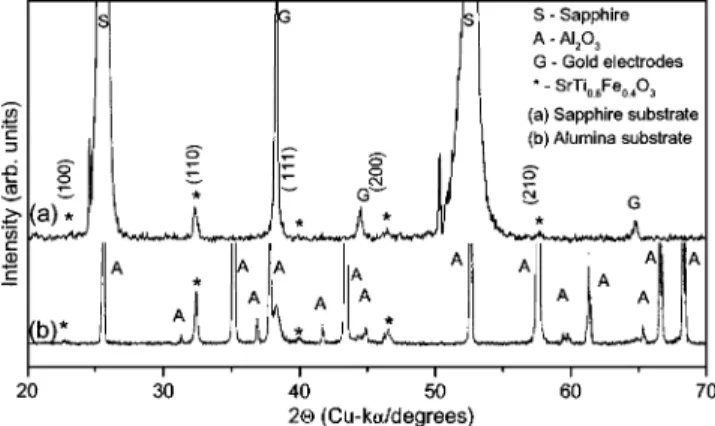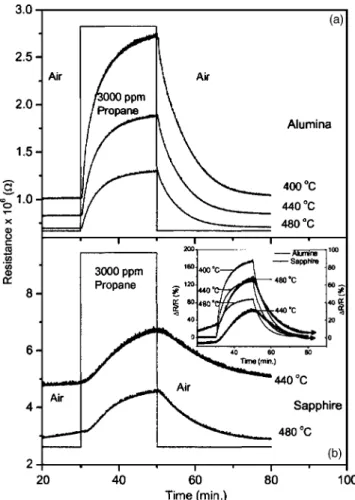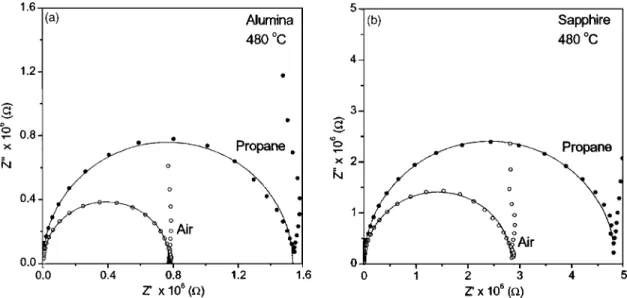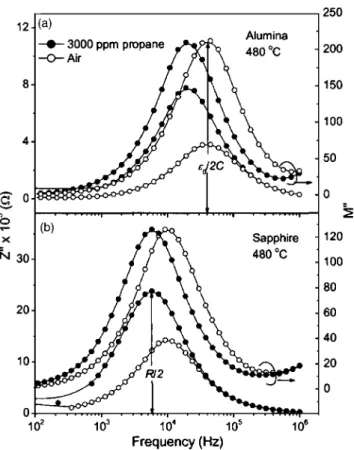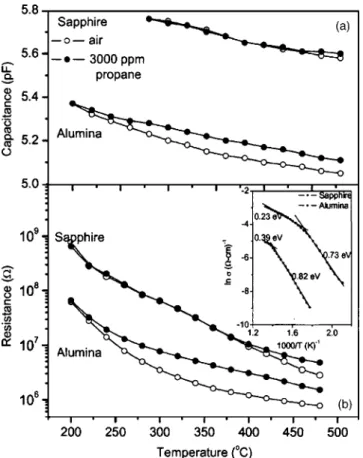Effect of grain boundaries on hydrocarbon sensing in Fe-doped
p-type
semiconducting perovskite SrTiO
3films
M. Mahesh Kumara兲and M. L. Post
Institute for Chemical Process and Environmental Technology, National Research Council of Canada, 1200 Montreal Road, Ottawa, Ontario KIA OR6, Canada
共Received 1 February 2005; accepted 5 April 2005; published online 7 June 2005兲
Films of Fe-doped SrTiO3deposited using pulsed laser deposition on sapphire and alumina, when
exposed to propane, showed different sensor responses measured 共as a resistance change兲 as a function of temperature and microstructure. The film deposited on alumina has a stronger response towards 3000-ppm propane than does the film deposited on sapphire. Films deposited on alumina exhibit higher dc conductivity than the films on sapphire. The activation energies indicate a mixed electronic/ionic conduction at low temperature with the high-temperature regime showing a temperature-independent conductivity. The origin of the difference in gas responses caused by varying temperature and morphology has been explored using ac impedance techniques and measured as a function of frequency 共1 Hz艋 f 艋1 MHz兲 and temperature 共200艋T艋480 °C兲. A single relaxation共a single semicircle in the complex impedance plane兲 in the frequency domain was observed in addition to the relaxation due to the electrode-film interface. A model and a mechanism of conduction for the above are derived using equivalent circuits to fit the ac impedance data and dc conductivity. It is proposed that the reduction of Fe-doped SrTiO3, which is induced by propane,
enhances the space-charge barrier near the grain boundaries and increases the sensitivity to propane. © 2005 American Institute of Physics.关DOI: 10.1063/1.1922584兴
I. INTRODUCTION
Demand for chemical sensors has been growing at a con-sistent pace in recent years due to the stringent environmen-tal regulations that are coming into effect to reduce emis-sions and hazardous pollutants. Miniaturization and severe environmental conditions have set demands on such sensors. Ideal sensors should not only selectively and sensitively measure the presence of one particular gas but also must be robust and cost effective. Several metal oxide sensors which operate on the principle of conductometric changes have been in the market for a while, to sense gases ranging from simple oxygen to complex hydrocarbons. The most com-monly available are based on doped SnO2and ZnO.
1
One feature that is common to most of the commercially available conductometric sensors is that the conductivity is of n type and there are only a few sensors which have p-type conductivity. The metal oxide SnO2 is one of the
well-investigated and better understood semiconductor gas sen-sors that has been widely used to detect low concentrations of gases. However, SnO2sensors suffer from the poor
selec-tivity and low hydrothermal stability necessitating a more selective and stable sensor.2–4 Another important factor to consider while performing a sensor measurement 共which is generally resistance as a function of time and gas concentra-tion兲 in an n-type sensor such as SnO2 is the magnitude of
the resistance. In an n-type semiconductor, the resistance de-creases in the presence of a reducing gas and should there be a large resistance decrease, the conventional two-probe resis-tivity measurements become untenable at low values of
re-sistance, compelling a change in the measurement technique and rendering it to misrepresentation of the true sensitivity.
As an alternative, a p-type semiconductor where the magnitude of resistance increases as a function of time in reducing gas concentrations has been chosen. The resistance rise allows sensor response measurement with no concerns about loss of accuracy at higher concentration of analytes. In addition, by modifying composition and morphology, the
p-type semiconductors can be made stable for fluctuating
temperatures and humidity. Materials with perovskite struc-ture are receiving increased attention in this regard, which include simple perovskites such as SrTiO3 that are stable
over a large temperature range. Similarly, SrFeO3-␦ is
an-other p-type semiconducting perovskite material, which has promising characteristics for a gas sensor.5 Unlike the former, the oxygen nonstoichiometry induces structural phase transitions in SrFeO3-␦共0⬍␦⬍0.5兲. A change in
oxy-gen stoichiometry leads to the redox reaction of Fe4+ Fe3+
and the electronic transition constitutes a conduction mecha-nism which has repercussions in its gas-sensing properties. When these two perovskite compounds are mixed in sto-ichiometric molar ratios, solid solutions are formed, which are intrinsically depleted in oxygen. With varying oxygen stoichiometry, it was found that Sr共FeTi兲O3-␦ can show
al-most temperature-independent conductivity in a large regime at high temperatures, which is ideal for a gas sensor.5
Thin or thick film of the material on a substrate is the most common configuration that is used for a device in gas-sensing measurements. Sr共FeTi兲O3, when exposed to reduc-ing species such as hydrocarbons at atmospheric pressures, behaves as a p-type semiconductor and the rise in resistance
a兲Author to whom correspondence should be addressed; electronic mail:
mahesh.matam@nrc.ca
for the sensitivity of Sr共FeTi兲O3 to propane by means of
analyzing the ac impedance data measured over a large fre-quency and temperature ranges in both air and propane. It reports the results obtained on conductometric gas sensor responses, dc conductivity, and ac impedance spectroscopy, and proposes a model for the sensitivity for one particular composition of SrTi0.6Fe0.4O3-␦ with propane. The
measure-ments were done with films deposited by pulsed laser depo-sition and a comparison of the results obtained for films de-posited on single-crystalline sapphire and on polycrystalline alumina has been undertaken.
II. EXPERIMENT A. Film preparation
Targets of SrTi0.6Fe0.4O3 共hereafter called STF40兲, for
pulsed laser deposition 共PLD兲, are prepared by solid-state reactions using stoichiometric amounts of SrCO3, Fe2O3, and
TiO2. The powders were thoroughly mixed and were prefired
in a tube furnace in flowing Ar at 1050 °C for 1500 min. Prior to pressing the powder into a pellet, the powders were again mixed and sintered at 1150 °C for 1500 min in flowing O2. A final sintering was carried out on pellets at 1430 °C for
1500 min in flowing oxygen. The targets obtained were dense共80%兲 and black in color. The target was then used in PLD to deposit thin films of STF40 on substrates of single-crystalline sapphire共11¯02兲 and polycrystalline alumina. The PLD conditions for deposition were wavelength of the exci-mer laser 共KrF兲 共Lambda Physik, LPX305i兲 =248 nm, pulse frequency of 8 Hz, and energy of 600 mJ. Fluence at the target was estimated to be 1.6 J / cm2. The depositions
were carried out in an atmosphere of oxygen at a partial pressure of 13.3 Pa with the substrate temperature at 700 °C. After the deposition, films were annealed at the same tem-perature with oxygen partial pressure elevated to 53.3 kPa for 30 min and the temperature then lowered to ambient at a controlled rate. The thickness of the films deposited was es-timated to be⬃200 nm.
B. Structural and microstructural characterizations Phase identification was done on the sapphire- and alumina-coated films using x-ray diffraction, measured in the 20°艋2艋70° range at room temperature using Cu K␣ radia-tion 共Bruker D8 diffractometer兲. Images of microstructure
were obtained using a field-emission gun scanning electron microscope共FEGSEM兲 of Hitachi S4800 with an accelerat-ing voltage of 0.5 kV. Thermal analysis was measured on powder samples using a TA instruments’ thermogravimetry analysis共TGA兲 in flowing air and in 3000-ppm propane after the temperature was stabilized at 450 °C for over 100 min. Prior to this, the powders were taken to a temperature of 800 °C in air in order to remove volatiles and cooled to 450 °C at 10 °C/min.
C. Electrical characterization of films
Prior to the electrical measurements, two gold pads were evaporated onto the film to serve as electrodes. Two-probe conductometric gas-sensing measurements in flowing air
共21% oxygen in nitrogen兲 and propane 共3000 ppm in
syn-thetic air兲 were carried out in a 1-L chamber at a flow rate of 100 cm3/ min, where the temperature of the film could be
varied between 30 and 500 °C. dc conductivity and ac im-pedance studies were made using a Keithley 2400 DMM and a Solartron 1260 impedance analyzer, respectively, in the temperature range of 200艋T艋480 °C. dc conductivity was measured at 10 °C increments with temperature stabilization for over 30 min. Impedance was measured at 20 °C intervals as function of frequency 共1 Hz艋 f 艋1 MHz兲 in air and in propane. Impedance data were analyzed and fitted with equivalent circuits using the programZVIEW 2.
III. RESULTS AND DISCUSSION A. X-ray diffraction
It was found that SrTiO3–SrFeO3forms a complete solid solution system with the structure distorting away from the cubic to orthorhombic to tetragonal with the increasing con-centration of SrFeO3.
9
This paper, however, reports the re-sults obtained on the electrical properties of 60% SrTiO3-40% SrFeO3 共STF40兲 and has been selected in view
of this film strongest response to propane.10
Figure 1 shows the x-ray diffraction pattern obtained for the STF40 films deposited on single-crystal sapphire and polycrystalline alumina at room temperature. Films depos-ited on sapphire show, in addition to the Bragg peaks from
on共a兲 sapphire and 共b兲 alumina. The unmarked intensities in 共b兲 are from the substrate Al2O3- and Au-evaporated electrodes. The asterisks共ⴱ兲 indicate the STF40 intensities.
STF40, strong intensities of the sapphire substrate and the Au film used as the electrode. No impurity phase is evident and the structure is close to cubic perovskite, all the intensi-ties of SrTiO3are observed indicating the polycrystalline na-ture of the film. The x-ray spectrum of the film deposited on polycrystalline alumina also shows a polycrystalline STF40 without traces of impurity.
B. Microstructure
The formation of a nanomorphology in the film using PLD is clearly revealed in the FEGSEM images shown in Fig. 2. The films of STF grown on sapphire关Fig. 2共a兲兴 and alumina 关Fig. 2共b兲兴 show uniformity with grain sizes ap-proximating to⬃50 nm 关embedded nanograins of STF40 on the larger grains 共⬃1m兲 of the substrate Al2O3 could be
seen in Fig. 2共b兲兴. Films on sapphire appear to have a porous structure when compared to the film on alumina. A compari-son of the films indicates that the film grown on alumina appears to have a greater density than the film grown on sapphire. The ensuing sections will show the profound effect that microstructure has on the propane-sensing characteris-tics of STF40. The sensor responses共detailed in the ensuing sections兲 reveal that the sensing characteristics are greatly affected by the substrate microstructure and the film thick-ness.
C. Sensor response/dc conductometric measurements The conductometric sensor response of STF40 films was studied as a function of time and propane concentration. The response, measured as a change in dc resistance against time at various temperatures, is shown in Fig. 3. Figure 3共a兲
shows the response of STF40 film deposited on alumina to 3000-ppm propane and Fig. 3共b兲 that of the film deposited on sapphire. Temperatures around 400 °C are optimized to pro-vide adequately fast response kinetics to hydrocarbons. The percentage of response is calculated using the relation
⌬R
R 共%兲 =
Rgas− R0
R0
⫻ 100. 共1兲
The film deposited on alumina shows a stronger re-sponse关see inset of Fig. 3共b兲兴 to 3000-ppm propane 共160% at 400 °C兲 as compared to the film on sapphire 共65% at 480 °C兲. In films deposited on sapphire not only that the response is smaller but also the response time is longer. This could be due to a slow reaction on the film surface due to higher density. However, the film on alumina reacts more rapidly producing a more rapid response. Another notable feature is that the STF40 film on alumina responds at a lower temperature to propane than STF40 on sapphire. The stron-gest response for the film deposited on alumina was obtained at 400 °C as opposed to 480 °C for the film on sapphire. Hence in all respects, the film on alumina appears to be a better choice for sensing a hydrocarbon such as propane than a film on sapphire. The influential parameter for the strong differences in responses may lie in the electrical microstruc-tures of both the substrate that is used and film deposited on it.
FIG. 2. Images of scanning electron microscope of SrTi0.6Fe0.4O3 on共a兲 sapphire and共b兲 alumina.
FIG. 3. Conductometric sensor responses in 3000-ppm propane and air.共a兲 SrTi0.6Fe0.4O3film on alumina and共b兲 film on sapphire. Inset 共b兲 relative response to propane calculated using Eq.共1兲.
D. Impedance spectroscopy
As a member of the family of perovskite compounds,
which show a variety of properties based on the
microstructure,7,8exploring electrical charge transport across the grains and grain boundaries is the key to understanding the hydrocarbon response to STF40. Strikingly, in SrTiO3
such as perovskites, it was found that the grain-boundary resistance dominates over the interiors of the bulk.11Seminal works of Waser and co-workers12,13have established through simulations that the grain-boundary potential barrier height and the conductivity near the space-charge depletion region increase the resistance greatly in an acceptor-doped SrTiO3.
The enhanced response in the STF40 to propane is a result of the enhanced activity of the space-charge depletion region near the grain boundaries. The redox reaction has the ability to increase the influence of space charge, evaluation of which is only possible by an electrical means. Impedance spectros-copy, Z*共f ,T兲 共where f is the frequency and T is the tempera-ture兲, could provide insights into the effects of space-charge barrier, with its ability to distinguish between the relative strengths of grain interior and grain-boundary regions, when measured in the frequency domain over a few decades of f. A thorough analysis with different formalisms of Z*, M*, Y*, *and modeling the data to equivalent circuits facilitate the
calculation of resistance共R兲 and capacitance 共C兲 of different regions in a material. The capacitance directly implies the charge accumulation near the grain boundaries, which is thought to be a cause for the high resistivity in SrTiO3, with the resistance indicating the space-charge barrier height. There have been many reports and reviews14,15on the imped-ance spectroscopy, the analysis and acquiring information using different formalisms in thick films or dense polycrys-talline ceramics in contrast with very little information avail-able on thin films. In the present work impedance spectros-copy is applied to thin films to model electrical microstructure.
Figures 4共a兲 and 4共b兲 show the complex plane plots
共Col-Col plots兲 for the STF films deposited on alumina and
sapphire at 480 °C. The plots show a semicircle共a common feature observed in most polycrystalline ceramics and films attributed to one particular region兲 with a “spike” at low frequencies. At high frequencies the impedance 共Z
⬘
and Z⬙
兲 approaches the origin indicating low impedances. The semi-circle is generally modeled as a parallel combination of re-sistance R and capacitance C with its center on the real axis. With the knowledge of R, the capacitance C can be calcu-lated using the equation=−1= RC, with= 2fmax, where is the relaxation time, is the relaxation frequency, and
fmax is the peak frequency.
The enhanced impedance response to propane is clearly reflected with an increase in impedance on the application of propane 关Figs. 4共a兲 and 4共b兲兴. The resistance values calcu-lated from the intercepts on the real axes in air and propane are in concurrence with the increase in resistance on the ap-plication of propane in the dc conductometric gas response data 共Fig. 3兲. The higher values of resistance in films on sapphire may be due to the single-crystalline nature of its substrate, whereas alumina being polycrystalline is not prone to anisotropic effects and should partly be contributing to the overall resistance of the film.
The spike in the Col-Col plots at low frequencies indi-cates a simple capacitor, with an extremely small R value in series with the parallel RC at high frequencies of the semi-circle. An inspection of the high-frequency data indicates a positive intercept on the real axis instead of a zero imped-ance value indicating a very low resistimped-ance value in series with the parallel RC共large semicircle兲.
In order to accurately model the entire STF40 film, data are replotted in electrical modulus formalism, which is strongly sensitive to capacitance and low frequencies. Thus electrical modulus 共M
⬙
兲 when plotted against frequency, similar to the Bode plot of impedance, exhibits a Debye-like peak with a height which is inversely proportional to the capacitance 共C兲 of the region. By using the relaxation time共兲, the values of R can be extracted 共Fig. 5兲.
FIG. 4. Complex plane plots共Col-Col diagrams兲 for STF40 film deposited on 共a兲 alumina and 共b兲 sapphire. The lines are fits to the points using equivalent circuit model.
The electrical modulus as a function of frequency is shown in Fig. 5, and exhibits Debye-like peaks around fmax.
The combined plot also indicates thecoinciding for Z
⬙
andM
⬙
共solid circles or open circles in Fig. 5兲 at low frequenciesresulting from one particular region共grain/grain boundaries兲 of the film. With the increase in frequency, at f⬎1 MHz, the trend in M
⬙
appears to show an increase resulting in an ad-ditional relaxation at frequencies higher than 1 MHz. This particularly important feature is absent in the Z⬙
spectrum, which is insensitive to capacitive effects. The combined plot of Fig. 5 thus enables us to establish and conclude that at f⬎1 MHz, there are additional relaxations 共parallel RC
com-bination, possibly with a high capacitance兲 pertaining to an-other region of the film, in addition to the one already re-vealed in the complex plane. The experimental limitations did not permit obtaining a spectrum beyond the frequency of 1 MHz, which could have otherwise revealed the semicircle related to the second relaxation.
Additional information in the modulus data reveals共M
⬙
兲 that exposure to propane induces a marginal increase in the magnitude of the M⬙
measured at 480 °C. The increase in M⬙
for the film deposited on alumina 关Fig. 5共a兲兴 is relatively greater than that of the film on sapphire 关Fig. 5共b兲兴. This indicates an important result that additional charges are cre-ated on the exposure of propane to the film, marginally higher in the case of the film on alumina. However, the Z⬙
spectrum with a height which is directly proportional to the resistance shows a strong increase on the application of pro-pane, with a decrease in relaxation time in both the cases.As revealed by the combination of impedance and modulus spectroscopy, the relatively high-frequency regime does not only contain a single region but an additional region at f⬎1 MHz. A complete equivalent circuit thus consists of two parallel combinations of RCs connected in series with a series capacitance 共associated with the spike in Col-Col plots兲 at low frequencies.
Using the above analysis, a parallel combination of RC can be assigned to each region. The parallel RC at f
⬎1 MHz can be attributed to the grain interior or bulk
ef-fects. The low values of resistance observed in the Col-Col plots give credence to this assumption and also that grain interiors are generally low in resistance and offer little hin-drance to mobile charges.11 The second parallel RC combi-nation, which dominates the complex impedance plane and spectroscopic plots, is due to the grain boundaries. High val-ues of resistance are a characteristic of grain boundaries. In the ensuing sections, the reasons for high resistance near grain boundaries will be dealt with.
The grain boundaries in acceptor-doped SrTiO3 are
known to generate resistances at least four orders higher than the interiors of grains.15This is due to the presence of space-charge depletion regions on both sides of the grain bound-aries, which are generally positively charged and donor in nature. This forms a back-to-back Schottky barrier which
resists the movement of charges across the grain
boundaries.14An evidence for this is obtained from the spec-troscopic plots of real 共Z
⬘
兲 and imaginary parts 共Z⬙
兲 of the impedance, as shown in Fig. 6. In a parallel combination ofRC the low-frequency part of the impedance spectrum is
dominated by the dc resistance until the relaxation frequency
共兲 is reached. As f →1/, the reactive part of the RC starts to dominate the overall impedance up to high frequencies. At low frequencies, the reactive part of the RC has a high value of resistance thus effectively making dc resistance contribute to the overall impedance.
A scenario that can be visualized from the above find-ings is that the space-charge barrier, reflecting the Z
⬙
spectra, due to the depletion of the mobile charges near the grain boundaries offers high resistance to the species attempting to cross the grain boundary. Moreover, the Z⬘
spectrum, which is mostly due to the resistive component in RC circuit, offersFIG. 5. Combined spectroscopic plot of Z⬙and M⬙for STF40 film on共a兲 alumina and共b兲 sapphire. Note that the peak height of Z⬙is proportional to
R / 2 and M⬙to0/ 2C. The lines are fits to the points using an equivalent circuit model.
FIG. 6. Spectroscopic plots of Z⬘and Z⬙for STF40 exposed to propane and air at T = at 480 °C.
relatively lower resistance and is observed up to low fre-quencies. At f⬎1/, the total impedance decreases as a re-sult of the decrease in the reactance of the capacitance indi-cating the decline in the depletion region near the grain boundaries. The conduction mechanism at these frequencies is complex with the agitation exerted on mobile charges by the frequency resulting in charge compensation and recom-bination and the ionized charges moving away from the grain boundaries. The high frequencies cause a localized hopping conduction with the conduction species having insufficient time to relax. Due to this, a gas response measured at high frequencies may not yield desired results as the grain bound-aries are no longer depleted of the mobile charges. This also confirms that the sensitivity of STF40 films to propane is due to the grain boundaries.
The R and C values as a function of temperature mea-sured in air and propane obtained by nonlinear least-square fittings 共NLSFs兲 are shown in Fig. 7. Films deposited on polycrystalline alumina show strong sensitivity to propane with a corresponding increase in both resistance and capaci-tance. Significant sensitivity in this case is obtained at tem-peratures as low as 275 °C关Fig. 7共a兲兴. The resistance 共R兲 and corresponding space-charge depletion region capacitance共C兲 also show a considerable increase upon exposure to propane. In contrast, the kinetics in the STF40 film deposited on sap-phire does not allow any clear propane response until the temperature approaches 400 °C关Fig. 7共b兲兴. The significantly higher response observed in films deposited on alumina also
The inset of Fig. 7共b兲 shows the conductivity variation as a function of reciprocal temperature 共Arrhenius plots兲. The conductivity increases with increasing temperature, which corresponds to the charge mobility and becomes independent of temperature as the temperature is further increased. The temperature-independent conductivity at high temperatures is a common occurrence in metal oxide semiconductors with
p-type semiconductivity under constant oxygen partial
pres-sures. At high temperatures, oxygen vacancies are created thermally according to
Oo→ Vo+ 2e−+
1
2O2. 共2兲
In donor-doped titanates where the oxygen vacancy con-centrations are low, the fine-grained ceramics sintered under oxidizing conditions show high insulating grains due to the cation vacancy occupation.1Whereas, in an acceptor-doped SrTiO3the increased number of oxygen vacancies introduces more defects which are compensated by the negative cation acceptor centers. This tends to decrease the conductivity. The opposing effect of thermal promotion increases the conduc-tivity and competition leads to little change in conducconduc-tivity as the temperature rises.1A band gap of 3.2 eV in SrTiO3
reduces to 2.1 eV with the addition of Fe and increasing Fe doping further reduces this band gap.18In an acceptor-doped perovskite, activation energy共EA兲 is given by
18
EA=共2Eg−⌬HRed兲/2. 共3兲
The band gap共Eg兲 decreases with increasing impurity cation concentration and the enthalpy共HRed兲 keeps increasing with
increasing temperature and oxygen vacancy concentration. Due to this, EA reduces to almost 0 eV and in some cases even results in negative values at higher acceptor doping levels.19 The EA values at high temperatures determined above are consistent with those reported for acceptor-doped titanates.18
The loss of oxygen at high temperature is also confirmed by TGA. The TGA in Fig. 8 shows a considerable weight loss with increasing temperature which it regains upon cool-ing to 450 °C, although the process is not completely revers-ible. On heating, the weight shows an initial decrease and appears to gain at temperatures in excess of 300 °C, before it loses considerable weight at T⬎400 °C. The initial weight loss and gain does not emanate as a consequence of the oxy-gen loss, and recombination could be due to extraneous ef-fects of either moisture or other volatile contamination. The
FIG. 7. 共a兲 C and 共b兲 R values calculated from the fits to the equivalent circuits as a function of temperature for the STF40 film deposited on sap-phire and alumina. Inset 共b兲 shows the dc conductivity as a function of inverse temperature. Values of activation energies共EA兲 are indicated.
direct effects of an oxygen loss which greatly influences the conduction mechanism were not seen in the dc conductivity plot in the temperature ranges of weight loss and gain, con-firming the above assumption.
TGA at 450 °C in 3000-ppm propane also allows in-sights into the mechanism which leads to an enhancement in response as a function of gas concentration. On the applica-tion of propane, a clear weight loss in the sample is ob-served, which is regained after its exposure to air. The weight loss is associated with the reduction reaction which can be nominally shown in the following:
SrTi0.6Fe0.4O3+ C3H8+共5-␦/2兲O2 → SrTi0.6Fe0.4-␦ 4+ Fe ␦ 3+O 3-␦+ 3CO2↑ + 4H2O↑. 共4兲
Although at the molecular level the mechanism of oxi-dation is not completely understood, the catalytic oxioxi-dation of propane occurs with the source of oxygen both from the gas phase and from the oxygen in the STF40 lattice. This is accompanied by the redox couple of Fe4+ Fe3+, for charge balance, which in turn contributes to the oxygen vacancies in the film.
In a model proposed recently for p-type
semiconductors,20 the thin oxygen adsorption layer on the surface surrounding the grain-boundary layers acts as an electron trap. The electrons that are released as a result of the redox reaction diffuse towards the negative electrode and are trapped in the acceptor sites of the adsorbed oxygen near the grain boundaries.21 Due to this trapping the charge-carrier density near the grain boundaries considerably decreases and thereby increases the height of the depletion layer leading to a resistance increase. This resistance increase is consistent with the resistance rise usually observed in p-type semicon-ductors. The redox reactions are just not confined to the mag-nitude of depletion barrier and the trap levels created but also on the diffusion reaction and penetration of the hydrocarbon into the interiors of the film, which takes the pore sizes into consideration and does not per se deal with the substrate used.
In most ceramics, grain boundaries have smaller conduc-tivity as compared to either the electrodes or the bulk of the
region due to the depletion space-charge layers. The grain-boundary thickness is directly proportional to the conductiv-ity of the material given by12
gb⬇
dgb db
l, 共5兲
wheregb,l, dgb, and db are the conductivity of the grain boundary, long-term conductivity and thickness of grain boundary, and the bulk of the material, respectively. From the above, the thickness of the grain boundary is directly proportional to its conductivity. The SEM pictures 共Fig. 2兲 for films deposited on sapphire and alumina show varying grain-boundary thicknesses. As in most of the polycrystalline materials, the bulk conductivity is so high that it does not appear in the impedance spectrum due to the size of the grain-boundary space-charge thickness.
IV. CONCLUSIONS
SrTi0.6Fe0.4O3 can be deposited as polycrystalline films
on smooth and rough substrates. At elevated temperatures, they behave as p-type semiconductors and the electrical re-sistance increases when the films are exposed to reducing gaseous species. It was found that films substituted with Fe in SrTiO3 could sense hydrocarbons such as propane quite
strongly and be transduced as a significant change in electri-cal conductivity. The magnitude of the response varies with films deposited on sapphire and alumina towards propane as a result of differences in microstructure. Analysis using im-pedance spectroscopy clearly reveals contribution of the grain-boundary regions to the overall resistivity of the film. The single semicircle observed in the complex plane is at-tributed to the grain boundaries after a thorough analysis using electrical modulus formalism, which is more sensitive to the capacitance of a particular region. Additional contri-butions from the grain boundaries of alumina substrate result in the higher conductivity in films deposited on alumina as compared to those deposited on single-crystal sapphire. The redox reaction induced by the presence of propane enhances the space-charge barrier across the boundaries, which is re-alized as sensor response. Overall, STF40 films deposited on sintered alumina appear more promising as hydrocarbon sen-sor than the films on sapphire.
ACKNOWLEDGMENTS
The authors thank Xiaomei Du for assistance with PLD and Jim Margeson 共Institute for Research in Construction, NRC兲 for FEG-SEM images. Financial support of this project by National Research Council of Canada, in the NRC-Helmholtz collaborative program, is gratefully ac-knowledged Grant No.共NRCC-21-CRP-02兲.
1
P. T. Moseley and A. J. Crocker, Sensor Materials共IOP, London, 1996兲. 2
P. T. Moseley, Meas. Sci. Technol. 8, 223共1997兲. 3
F. H. Chibirova and E. E. Gutman, Russ. J. Phys. Chem. 74, 1555共2000兲. 4
D. Orlik, M. Ivanovskaya, and A. Gurlo, Zh. Anal. Khim. 52, 69共1997兲. 5
J. J. Tunney and M. L. Post, J. Electroceram. 5, 63共2000兲. 6
O. Saburi, J. Phys. Soc. Jpn. 14, 1159共1959兲. 7
G. D. Mahan, L. M. Levinson, and H. R. Phillipp, J. Appl. Phys. 50, 2799
共1979兲.
8
T. Takahashi, High Conductivity Solid Ionic Conductors共World Scientific, FIG. 8. Thermogravimetry of STF40, depicting the weight loss as a function
